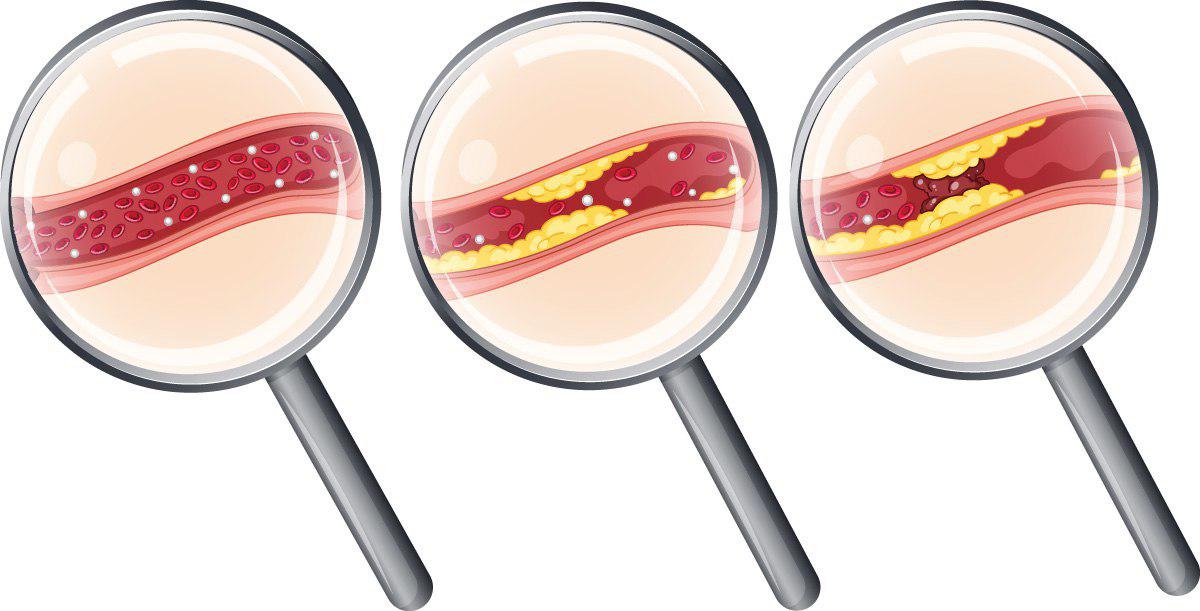High cholesterol is known for triggering several chain reactions in your body, affecting your overall health. When cholesterol deposits start sticking to the artery walls, they form plaques. Plaques lead to atherosclerosis. Atherosclerosis leads to coronary artery disease.

1. The risk of atherosclerosis increases with age
As your body grows older, the heart has to work harder to pump blood. This, in turn, causes the arteries to lose their elasticity, which means they become weaker. When this happens, the risk of plaque build-up also increases, making it more likely for you to end up with atherosclerosis.
In fact, the risk of ending up with coronary artery disease increases in women aged 55 and above, while for men, the threshold that exposes them is 45 years of age.
2. Atherosclerosis may show no symptoms
Typically, atherosclerosis is a condition that has no symptoms until there is actually a blockage inside the artery. This blockage is normally a blood clot which forms when the plaques rupture. Even if they don’t, these lumps on the inner lining of the arteries can grow so big, they prevent blood from passing through the arteries.
3. Atherosclerosis: Differentiating the symptoms of heart attack and stroke
People having a heart attack can experience breathing trouble, nausea and vomiting, excessive sweating, pain in the abdomen or chest region, and some may even feel pain in the arms, neck, shoulders, and back.
Those having a stroke may start to lose their cognitive functions and have trouble maintaining balance, could feel a sharp and sudden headache, can have trouble speaking and understanding what those around them are saying, may experience vision loss, and weakness or numbness in their limbs or in the face.
4. Severe atherosclerosis may require surgery
When atherosclerosis is in a more advanced stage, your skin and muscle tissue are in danger, in which case your doctor may recommend surgery. There are different types of surgery for atherosclerosis, which include:
- An angioplasty. This procedure involves inserting a catheter and a balloon in the narrow artery, inflating the balloon to expand it. In some cases, doctors may choose to insert a stent, which permanently keeps the artery open.
- A bypass surgery. Through this procedure, the surgeon tries to redirect blood away from the narrow artery. This can be done in multiple ways, either by using a synthetic tube to divert the blood or by using another vessel to do so.
- Thrombolytic therapy. This particular method involves injecting a drug into the problematic artery in order to dissolve the blood clot.
- An atherectomy. The plaques formed in the arteries are removed by using a catheter and a blade to cut the deposits.
- An endarterectomy. This surgery removes the fatty deposits found inside the artery.
5. Coronary artery disease symptoms for women are different
One of the most common symptoms of coronary artery disease is angina, which is severe pain in the chest region. Every person who has experienced it has a different description for it. Some claim it feels like squeezing, while others say it’s a burning sensation. It can also appear like a tight pain, or feel like something is putting pressure on your chest.
Note that a lot of people confuse these symptoms with those of indigestion or heartburn, so it’s best to seek medical attention immediately. Unlike men, women who have coronary artery disease are more likely to experience shortness of breath without angina, pain in the back and the jaw, nausea, and vomiting.
Other symptoms of atherosclerosis include dizziness, sweating, and pain in the shoulders and arms.
6. Lifestyle changes for atherosclerosis and coronary artery disease are identical
Treating coronary artery disease means treating atherosclerosis which, in turn, means treating high cholesterol. Because of that, the treatment path for these three problems are similar, and the lifestyle changes one must make in order to avoid high levels of cholesterol include:
- Consuming foods low in fat and cholesterol is very important. Your body already produces the cholesterol it needs for hormones and cell developments, so anything that you take from foods is unnecessary for the body’s well-being.
- Fish is an excellent source of omega-3 fatty acids, which have long been known as one of the major ways to lower your cholesterol levels. Replace two of your weekly meat meals with portions of cold-water fish, and you will be reducing the amount of LDL cholesterol in your bloodstream.
- Smoking doesn’t just affect your cholesterol levels, it can also damage your artery walls and cause the inner lining to be thinner and more exposed to damage.
- Getting at least 75 minutes of exercise per week is very important in maintaining an ideal weight. Obesity is one of the major risk factors for coronary artery disease, which means that you have to do everything in your power to watch those extra pounds. Through exercise, you will be improving your good cholesterol levels as well.
7. High cholesterol is not the only risk factor for coronary artery disease
The bottom line
The human body often reacts to things in sort of a domino effect, which is the case with high cholesterol levels. When there is too much cholesterol in your blood, it attached to the artery walls, causing atherosclerosis. This condition, in turn, leads to coronary artery disease, and while it’s not the role party responsible, it’s the most frequent one.
Because of that, watching the things you eat and drink, as well as being physically active can significantly reduce your changes or ending up with irreversible artery damage.


Your thoughts on this